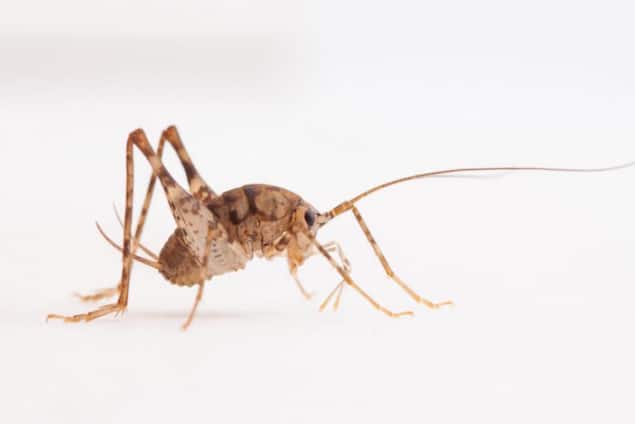
A micro-organism discovered in greenhouse camel crickets can degrade lignin from wood, say researchers in the US. The new finding, which kickstarted thanks to a citizen science project, could help in the quest to find other organisms that break down different types of polluting waste, such as plastic.
Many industrially produced compounds are relatively hard to degrade. Indeed, some are produced to be intentionally tough and long lasting. We not only need to reduce the production and accumulation of these recalcitrant materials in the future, say the researchers led by Stephanie Matthews of Campbell University and Rob Dunn at NC State University, we also need to urgently find ways to degrade those already present in landfills and the environment in general.
Degrading microbes
One promising strategy for dealing with this waste is to find microbes that can break it down. “We knew that camel crickets can eat almost anything, so we began to wonder what bacteria might be present in a camel cricket’s gut that allows them to do this,” says Dunn.
The researchers identified and tested a range of microbial organisms in camel crickets and focused on a strain of bacteria called Cedecea lapagei as being of particular interest. They found that this micro-organism can degrade lignin – the polymers in plant cells that make wood tough.
Lignin (or lignocellulose) is the most abundant biopolymer on Earth and is very difficult to break down. It could be used as biofuel, however, if it could be degraded into its sugar molecules. This is no easy task since lignin contains several types of monomers and distorts when chemically processed. Paper factories, for example, often simply incinerate it and use it for fuel rather than try to convert it into commercial bioproducts.
C. lapegei may be a valuable new resource in this context since it is capable of surviving in a wide range of conditions, says Matthews.
“What are they good for?”
The work was inspired by a 2014 citizen-science study involving camel crickets, in which the participants asked the researchers what these creatures (which are commonly found in our homes) might be good for. “It was this question that led us to consider more specifically whether their gut microbes might be able to live in and degrade black liquor – a waste product from the paper pulp industry that consists mainly of lignin,” explains Dunn.

Catechyl lignin could produce commodity chemicals
In their experiments, the researchers began by sterilizing the surface of camel crickets as well hide beetles (Dermestes maculatus), another common insect, to kill any bacteria on their exoskeletons and so focus on the ones in their gut only. They then homogenized the creatures and grew the bacteria on multiple food substrates, including both lignin on its own and lignin in black liquor.
“We then identified the bacteria that grew, compared them to known bacteria and subsequently studied them in more detail,” explains Dunn. “These studies included identifying some of the genes and enzymes of these bacteria that might be responsible for their unique abilities to grow on and degrade lignin.”
Repeatable approach for other types of waste
“As well as identifying bacteria potentially able to turn pulp paper waste into energy, and hence get rid of a pollutant, we’ve identified a repeatable approach to finding new useful organisms that might break down other types of waste,” Dunn tells Physics World. “This might include plastic or other products that cause major pollution problems.”
This project highlights the value of a workflow that starts with the study a particular ecosystem, evaluates the role of organisms in that ecosystem and then becomes increasingly specific – down to the level of each organism’s microbiome, adds Mathews. “At each step, you are collecting information that allows you make increasingly informed decisions about where to look for microbial resources that may have practical applications.”
The research is detailed in Royal Society Open Science 10.1098/rsos.180748 and is free to read.



